
JunOS_2_routingessentials
.pdf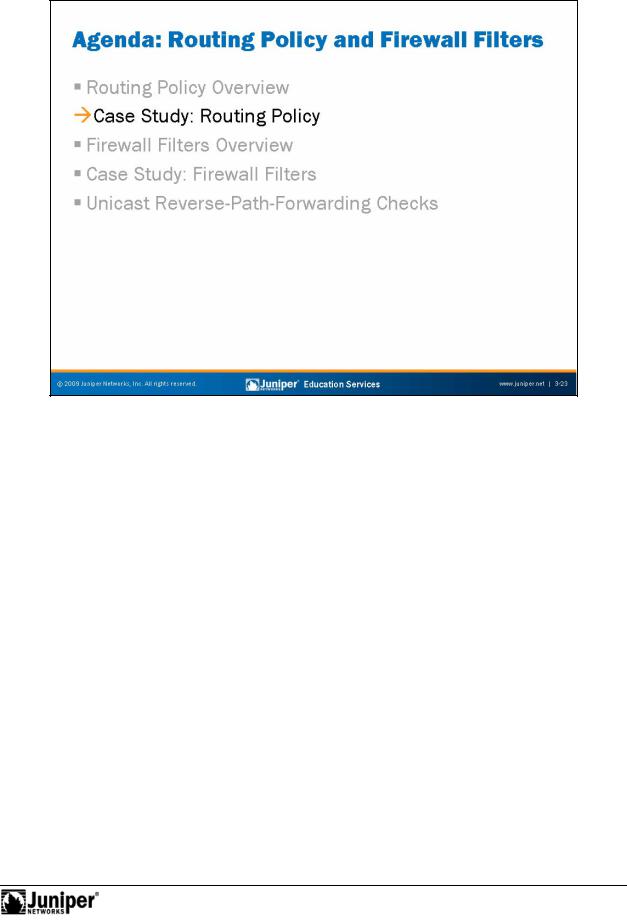
JUNOS Routing Essentials
|
|
Reproduction |
|
Case Study: Routing Policy |
|
|
The slide highlights the topic we discuss next. |
|
Not |
for |
|
|
|
|
Routing Policy and Firewall Filters • Chapter 3–23
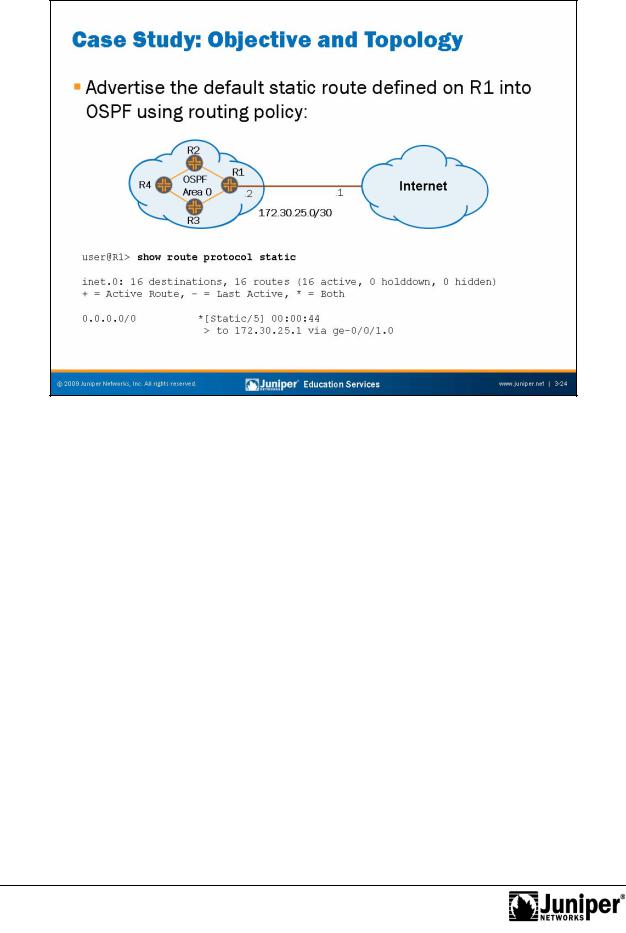
JUNOS Routing Essentials
Case Study: Objective and Topology
The slide introduces a routing policy case study objective and topology. The stated objective for this case study is to use routing policy to advertise R1’s default static
route into OSPF. |
Reproduction |
|
|
for |
|
Not |
|
|
|
|
|
Chapter 3–24 • Routing Policy and Firewall Filters
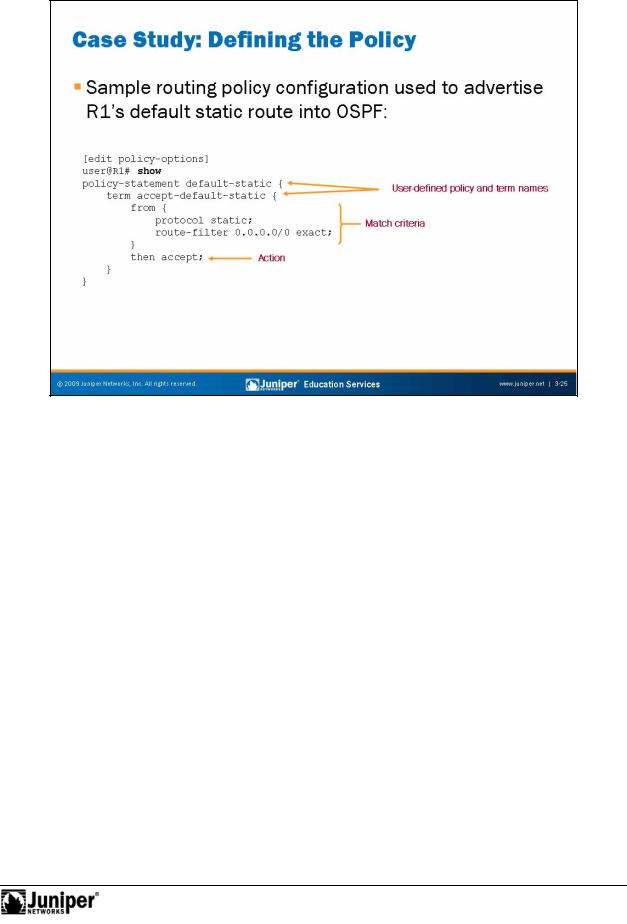
JUNOS Routing Essentials
Case Study:ReproductionD fining the Policy
The slide shows a sample routing policy configuration that you can use to accomplish forour p eviously stated objective.
Not
Routing Policy and Firewall Filters • Chapter 3–25
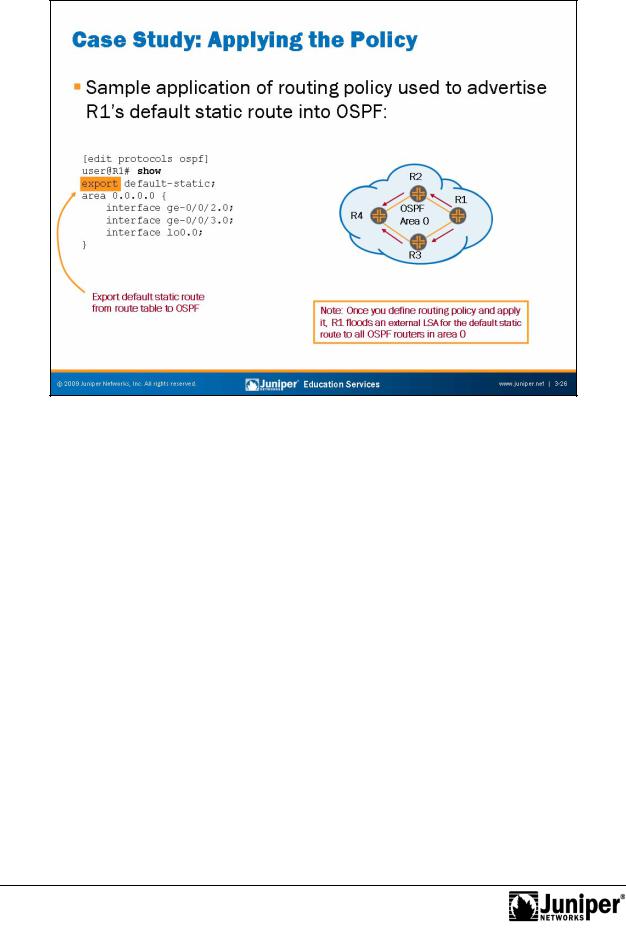
JUNOS Routing Essentials
Case Study: Applying the Policy
The slide shows the application of the sample routing policy defined on the previous slide. As noted on the slide, once th routing policy is applied and the new
configuration is activated through a commit, R1 should begin advertising the default |
|
route as an exte nal LSAReproductionto other routers within OSPF area 0. We verify this |
|
advertisement n the next slide. |
|
Not |
for |
|
|
Chapter 3–26 • Routing Policy and Firewall Filters
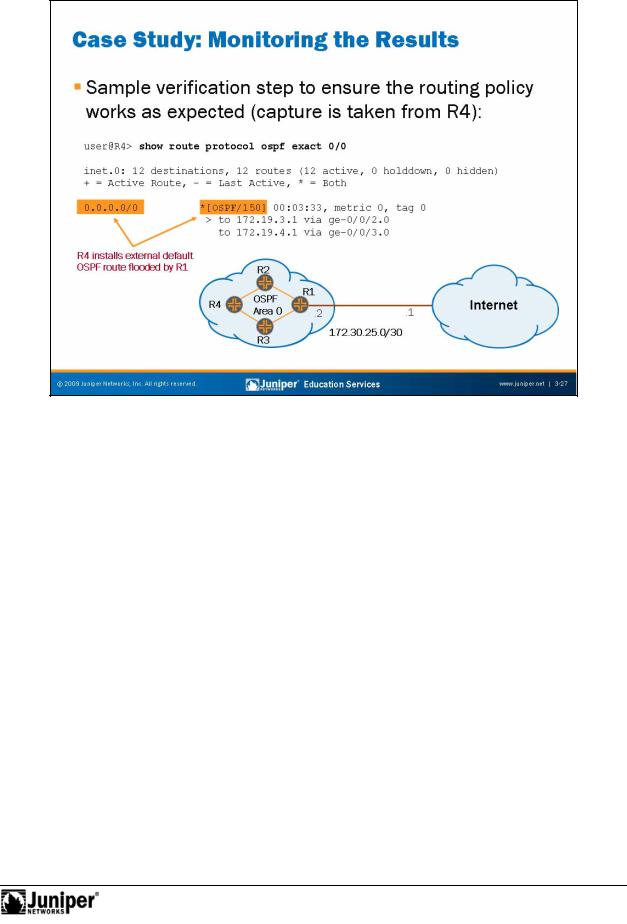
Not
JUNOS Routing Essentials
Case Study:ReproductionMonitoring the Results
The slide shows a sample verification step, which confirms the routing policy works as designed. Using the show route protocol ospf exact 0/0 CLI command, weforsee R4 has added the default external OSPF route to its route table.
Routing Policy and Firewall Filters • Chapter 3–27
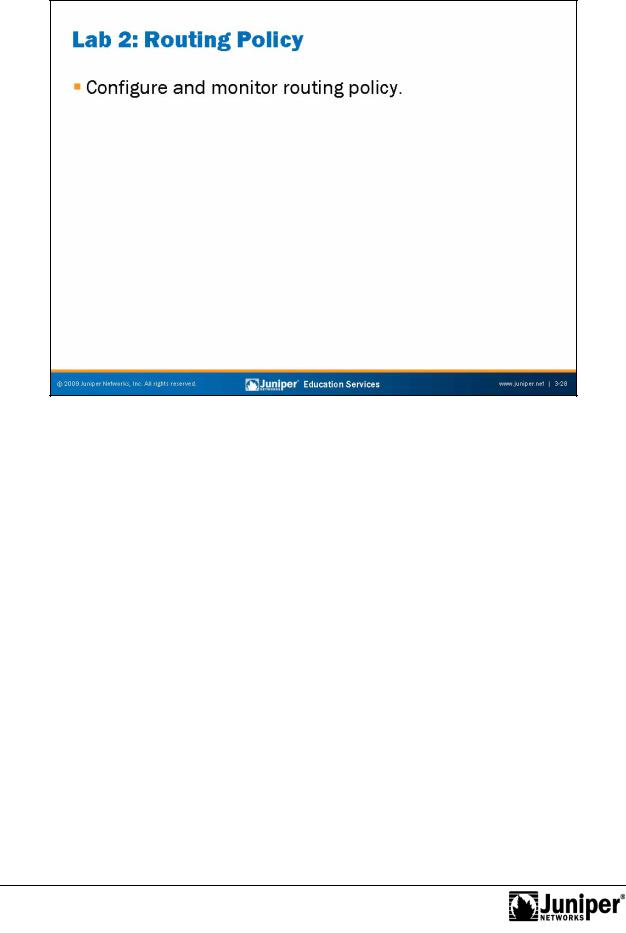
JUNOS Routing Essentials
|
|
Reproduction |
Lab 2: Routing Policy |
||
The slide provides the objective for this lab. |
||
Not |
for |
|
|
|
|
Chapter 3–28 • Routing Policy and Firewall Filters
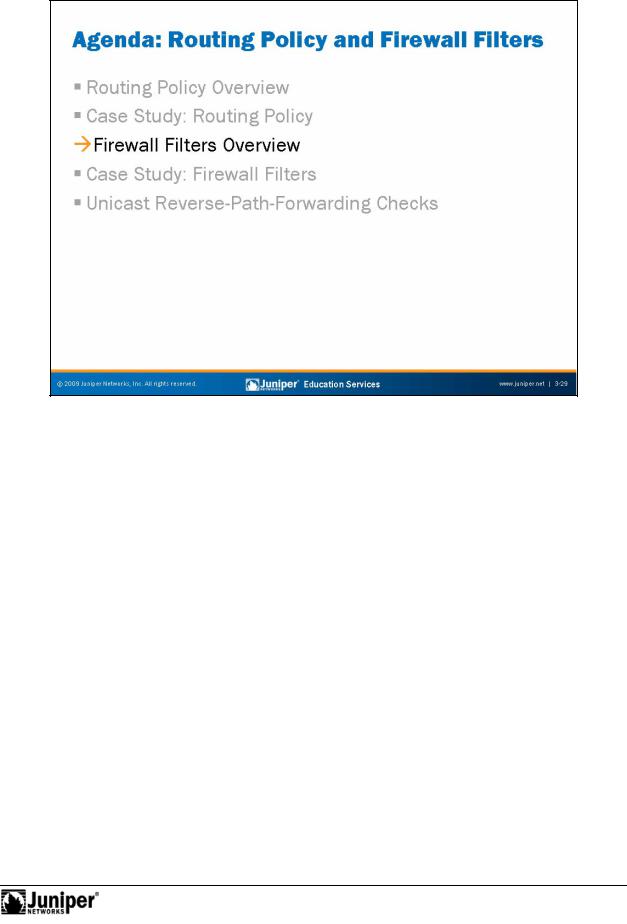
JUNOS Routing Essentials
|
|
Reproduction |
|
Firewall Filters Ov rvi w |
|
|
The slide highlights the topic we discuss next. |
|
Not |
for |
|
|
|
|
Routing Policy and Firewall Filters • Chapter 3–29
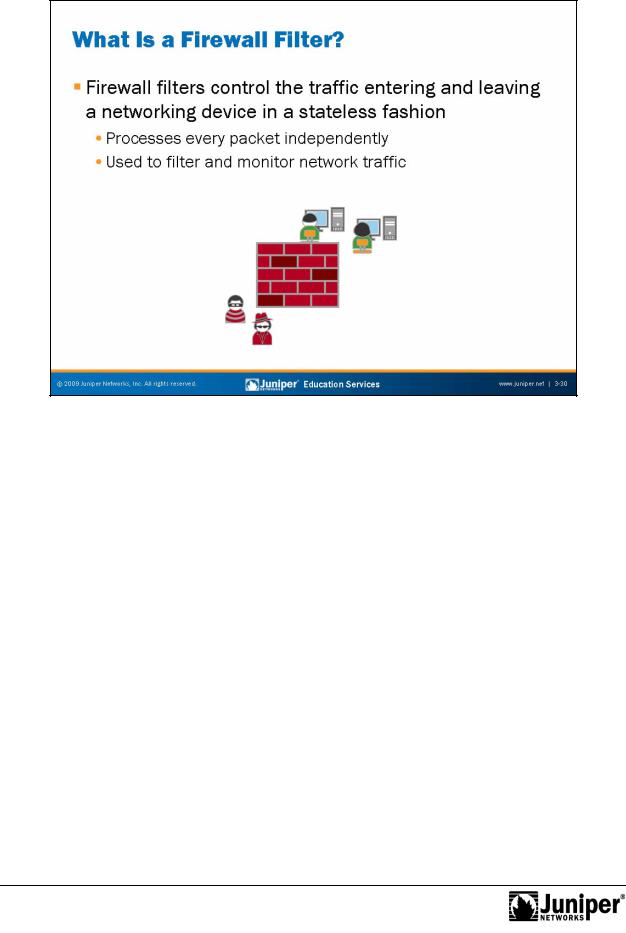
JUNOS Routing Essentials
them to control t affic passing through a JUNOS device.
Firewall filters are oftenReproductionreferred to as access control lists (ACLs) by other vendors. JUNOS Softwafore fi ewall filters are stateless in nature, and the software primarily uses
Stateless irewall filte s examine each packet individually. Thus, unlike a stateful firewall that tracks connections and allows you to specify an action to take on all
Notpacke s wi hin a flow, a stateless firewall filter has no concept of connections. The sta eless nature of these filters can impact the way you write your firewall filters. Because the system does not keep state information on connections, you must explicitly allow traffic in both directions for each connection that you want to permit. By contrast, stateful firewall filters only require you to permit the initial connection and then automatically permit bidirectional communications for this connection.
You can use firewall filters to restrict certain types of traffic from passing into and out of your network. You can also use firewall filters to perform monitoring tasks that help you formulate an effective security strategy for your environment.
Chapter 3–30 • Routing Policy and Firewall Filters
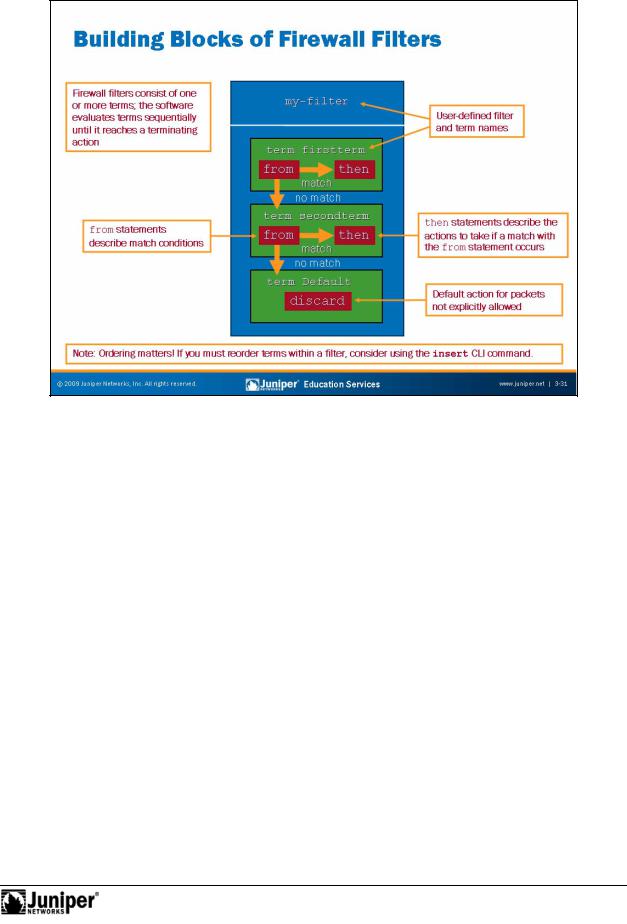
JUNOS Routing Essentials
Building Blocks of Fir wall Filters
Although routing policies and firewall filters serve different purposes and have different match and action conditions, they both have a common structure.
As with |
outing policy, the fundamental building block of a firewall filter is the term. A |
term c |
Reproduction |
ntains zero or more match conditions and one or more actions. If all the match |
|
c nditi |
ns are true, JUNOS Software takes the specified action within the term. If no |
ma ch conditions are specified, all traffic matches the firewall filter term and is |
|
subjectedforto the stated action. You use a filter to group together multiple terms and |
|
establish the order in which the system evaluates the terms. JUNOS Software firewall |
|
filters require at least one term. |
|
Not |
|
Firewall filters always include a default term that discards all packets that the configuration does not explicitly permit through the defined terms. When implementing firewall filters, keep in mind that the order of the terms is important and can impact the end results.
Routing Policy and Firewall Filters • Chapter 3–31
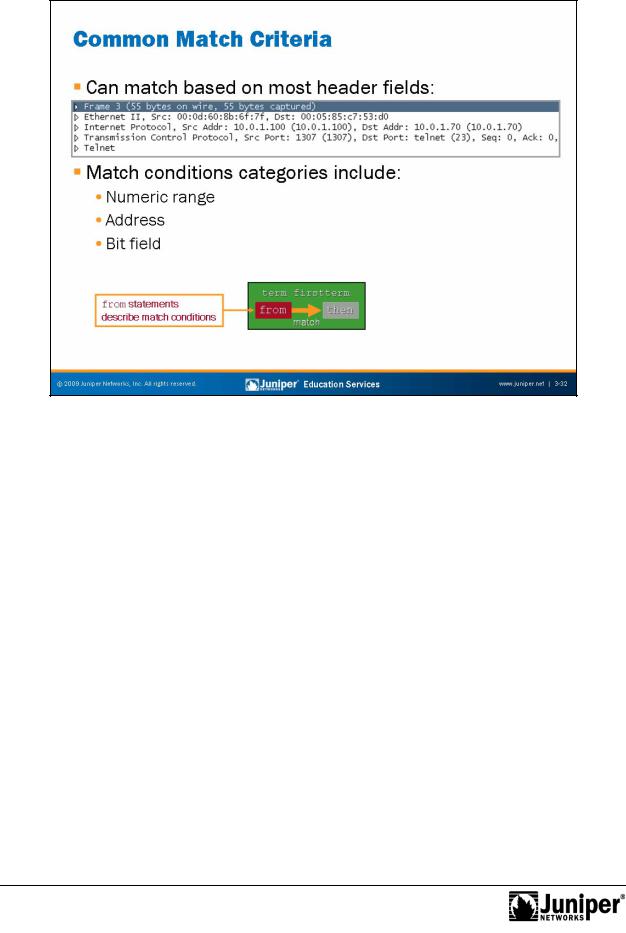
JUNOS Routing Essentials
Common Match CritReproductionria
You specify the criteria to use for matching packets in from clauses within firewall filter terms. You can use many header fields as match criteria. However, you must rememberforthat all header fields might not be available to you because of the way
firewall filters a e p cessed.
When you speci y a header field, JUNOS Software looks for a match at the location in the header where that field should exist. However, it does not check to ensure that the
Notheader field makes sense in the given context. For example, if you specify that the
s ftware should look for the ACK flag in the TCP header, the software looks for that bit to be set at the appropriate location, but it does not check that the packet was actually a TCP packet. Therefore, you must account for how the software looks for a match when writing your filters. In this case, you would have the system both check that the packet was a TCP packet and whether the TCP ACK flag was set.
The stateless nature of firewall filters can affect the information available in the processing of fragmented packets. Processing fragments is more complicated with stateless firewall filters than with a stateful firewall filter. The first fragment should have all the Layer 4 headers but subsequent fragments will not. Additionally, attempting to check Layer 4 headers in fragments produces unpredictable results. As was explained previously, JUNOS Software still attempts to evaluate the Layer 4 headers but the second and subsequent fragments do not contain these headers, so the matches are unpredictable.
Continued on next page.
Chapter 3–32 • Routing Policy and Firewall Filters
